The Hidden Magic of Traditional Thai Attire
Thailand captivates millions of visitors each year with its breathtaking landscapes, mouthwatering cuisine, and warm hospitality. Yet, there’s a profound dimension of Thai culture that many travelers miss entirely—the transformative experience of wearing traditional Thai clothing. Stepping into a chut thai (Thai costume) isn’t merely about donning beautiful fabrics; it’s about immersing yourself in centuries of cultural heritage that continues to thrive in modern Thailand. The elegant silhouettes, intricate patterns, and vibrant colors of traditional Thai garments tell stories of the kingdom’s rich history, from ancient Siamese courts to contemporary celebrations. When you wear these traditional outfits, you’re not just changing your appearance—you’re shifting your entire perspective on what it means to experience Thailand authentically. Local Thai people notice and appreciate foreigners who make this effort, often responding with genuine smiles, warmer welcomes, and more meaningful interactions that can transform an ordinary vacation into an unforgettable cultural journey.
Understanding the Cultural Significance of Chut Thai
The term “chut thai” encompasses various traditional Thai costume styles that have evolved through different historical periods and regions of the kingdom. These outfits aren’t simply historical artifacts—they remain deeply integrated into Thai society, worn during important ceremonies, royal events, weddings, and cultural festivals. For Thai people, these garments represent national pride, cultural identity, and respect for traditions passed down through generations. The fabrics, patterns, and accessories of each chut thai ensemble contain subtle symbols and meanings that reflect Thailand’s rich spiritual beliefs, social hierarchies, and artistic sensibilities. By choosing to wear traditional Thai clothing during your visit, you demonstrate respect for these cultural values while simultaneously participating in their preservation. This conscious choice signals to locals that you’re not merely passing through their country but genuinely interested in understanding its soul. The result is often a dramatic shift in how you’re perceived—from outsider to honored guest—opening doors to experiences that remain closed to the average tourist.
The Physical and Psychological Transformation
There’s something remarkably powerful about physically changing your appearance through traditional clothing. When you step into a properly fitted chut thai, you’ll notice an immediate difference in how you carry yourself. The structured elements of traditional Thai costumes naturally encourage better posture, more deliberate movements, and a heightened awareness of your surroundings. Women’s traditional outfits, with their graceful silhouettes and elegant draping, inspire a sense of refined femininity, while men’s costumes evoke feelings of dignity and presence. Beyond these physical changes, many travelers report a profound psychological shift when wearing traditional Thai clothing. There’s a unique blend of respect, curiosity, and connection that emerges when you make yourself vulnerable enough to step outside your comfort zone and embrace another culture’s traditional dress. This willingness to temporarily set aside your own cultural norms creates space for genuine cross-cultural understanding that simply isn’t possible when you remain in your familiar Western attire. The experience becomes a form of embodied learning—understanding Thai culture not just intellectually but through lived experience.
Breaking the Tourist Bubble
One of the greatest challenges travelers face in popular destinations like Thailand is breaking through the “tourist bubble”—that invisible barrier that keeps visitors in predictable patterns of interaction with locals who cater specifically to foreigners. Wearing traditional Thai clothing acts as a powerful catalyst for shattering this bubble. When locals see you in a chut thai, their perception shifts immediately—they recognize your effort and often respond with increased openness and willingness to share authentic aspects of their culture. Street vendors might offer you local prices rather than inflated tourist rates. Shopkeepers may invite you into conversations that go beyond simple transactions. Temple attendants might share deeper insights about religious practices that they wouldn’t typically explain to tourists. These natural, unscripted interactions become the highlight memories of your journey, creating stories worth telling for years to come. Rather than experiencing Thailand as a spectator, wearing traditional clothing allows you to participate in daily life, blurring the lines between visitor and temporary local in ways that enrich your travel experience immeasurably.
Photographic Memories That Stand Apart
Let’s be honest—travel photography has become increasingly homogenized in the age of social media, with millions of tourists capturing nearly identical images at popular landmarks. Wearing traditional Thai clothing creates opportunities for photographs that truly capture the essence of your unique experience in Thailand. Imagine your photos at the Grand Palace or Wat Arun where you’re not just standing in front of these magnificent structures but visually harmonizing with their cultural context. Traditional Thai costumes complement the architecture, colors, and atmosphere of Thailand’s historic sites in ways that Western clothing simply cannot. These images become treasured mementos that reflect not just where you went but how deeply you engaged with the culture. Local photographers at major attractions often become visibly excited when they see foreigners in traditional dress, offering creative suggestions and taking extra care with composition because they recognize the special nature of these images. The resulting photographs transcend typical tourist snapshots, becoming artistic representations of cultural appreciation that you’ll value long after your return home.
The Perfect Settings for Thai Costume Experiences
While wearing a chut thai can enhance virtually any Thai travel experience, certain settings provide particularly meaningful contexts for donning traditional attire. Historical sites like Ayutthaya, Sukhothai, or the ancient temples of Chiang Mai offer perfect backdrops where traditional clothing helps you connect more deeply with Thailand’s past. Cultural performances of traditional dance, music, or shadow puppetry become exponentially more meaningful when you’re dressed in harmony with the performers. Important Buddhist holidays and festivals present opportunities to participate respectfully in local celebrations while appropriately dressed. Even exploring Bangkok’s older districts, with their traditional architecture and ambiance, becomes a richer experience when your appearance reflects the cultural heritage of these neighborhoods. Each of these settings offers unique advantages for traditional costume wearing, creating opportunities for deeper cultural immersion that builds lasting connections to Thailand and its people. The contrast between ancient traditions and contemporary experiences becomes particularly striking when you navigate modern Bangkok while dressed in clothing that honors centuries of Thai cultural evolution.
Practical Considerations for Your Thai Costume Experience
For travelers interested in experiencing traditional Thai clothing, several practical considerations can help ensure a positive experience. First, quality matters—investing in a proper costume rental from a reputable provider offers an authentic experience that mass-produced tourist versions cannot match. Professional fitting makes a tremendous difference in both comfort and appearance, as traditional Thai costumes have specific draping techniques and accessory placements that require expertise. Climate considerations are important too; traditional silk costumes are best worn during cooler morning or evening hours, while lighter cotton versions may be more comfortable during Thailand’s hottest months. Cultural sensitivity remains essential—wearing these outfits respectfully means understanding appropriate contexts and behaviors while dressed in traditional attire. For instance, certain formal styles of chut thai wouldn’t be appropriate for casual street exploration, while simpler traditional outfits work beautifully for everyday tourism. Finding the right balance between authenticity and practicality ensures your traditional clothing experience enhances rather than complicates your Thai adventure.
Choosing the Right Outfit for Your Experience
Traditional Thai clothing encompasses a diverse range of styles developed across different historical periods and for various occasions. For women, options range from the elegant and formal Thai Chakri (inspired by royal court dress) to the more practical and comfortable Thai Boromphiman or Thai Chitlada styles. Men might choose between the dignified Raj Pattern suit or more comfortable traditional Thai shirt paired with chongkraben lower garments. Each style carries different cultural significance and practical considerations. When selecting your outfit, consider both the specific activities you’ve planned and the image you wish to convey. A visit to grand temples or historical sites might call for more formal traditional wear, while exploring markets or rural areas might be better suited to simpler traditional styles that allow for comfortable movement while still honoring Thai cultural traditions. Professional costume rental shops can provide valuable guidance on selecting appropriate styles based on your body type, planned activities, and the specific cultural contexts you’ll be experiencing during your Thai adventure.
Learning Through Dressing: The Educational Value
Beyond the immediate experience, wearing traditional Thai clothing offers remarkable educational opportunities that deepen your understanding of Thai culture. The process of being properly dressed in a chut thai becomes a fascinating cultural lesson in itself. As skilled attendants help you don each element of the outfit, they often share insights about the garments’ historical significance, the meaning behind different patterns or colors, and the occasions when various styles would traditionally be worn. You’ll learn about the exquisite craftsmanship involved in creating these garments, from hand-woven silks to intricate embroidery techniques passed down through generations. This hands-on learning experience provides cultural context that guidebooks simply cannot convey. Many travelers report that their costume experience inspired further exploration of Thai cultural history, textile arts, and traditional practices. The physical experience of wearing these clothes creates a tangible connection to abstract cultural concepts, making your entire Thai journey more meaningful and educational. This embodied learning stays with you long after you’ve returned home, influencing how you understand not just Thai culture but cultural differences more broadly.
Building Bridges Through Cultural Appreciation
In our increasingly connected world, thoughtful cultural appreciation serves as a powerful tool for building mutual understanding and respect. When you choose to wear traditional Thai clothing with knowledge and appreciation of its significance, you participate in a meaningful cultural exchange that benefits both visitors and locals. For Thai people, seeing foreigners embrace their traditional dress often inspires pride and renewed appreciation for their own cultural heritage. For travelers, the experience creates lasting connections and memories that transcend typical tourism. This form of cultural engagement represents travel at its best—not just seeing new places but genuinely connecting with different ways of being in the world. The relationships formed through these authentic interactions often become the most treasured souvenirs of your journey, creating bonds that may last for years through continued correspondence or return visits. In this way, the simple act of changing your clothes becomes a profound opportunity for personal growth and cross-cultural friendship that exemplifies the true purpose of travel: to expand our understanding of humanity’s rich diversity while recognizing our shared connections.
Experience the Magic of Thai Costume Rental at SiamCrown
Ready to transform your Thai adventure through traditional clothing? Visit SiamCrown at 236 Soi Luean Rit, Chakkrawat, Samphanthawong, Bangkok, where our expert staff will help you select and properly wear the perfect chut thai for your unique experience. Open daily from 8:00 AM to 4:30 PM (returns by 6:00 PM), we offer authentic, high-quality Thai costume rentals with professional fitting services and English-speaking staff to ensure your cultural journey begins perfectly. Browse our selection online at siamcrown.com or visit our boutique to discover how traditional Thai clothing can make your travels truly unforgettable. Don’t settle for ordinary tourism—embrace the extraordinary cultural immersion that only traditional Thai costume can provide!



